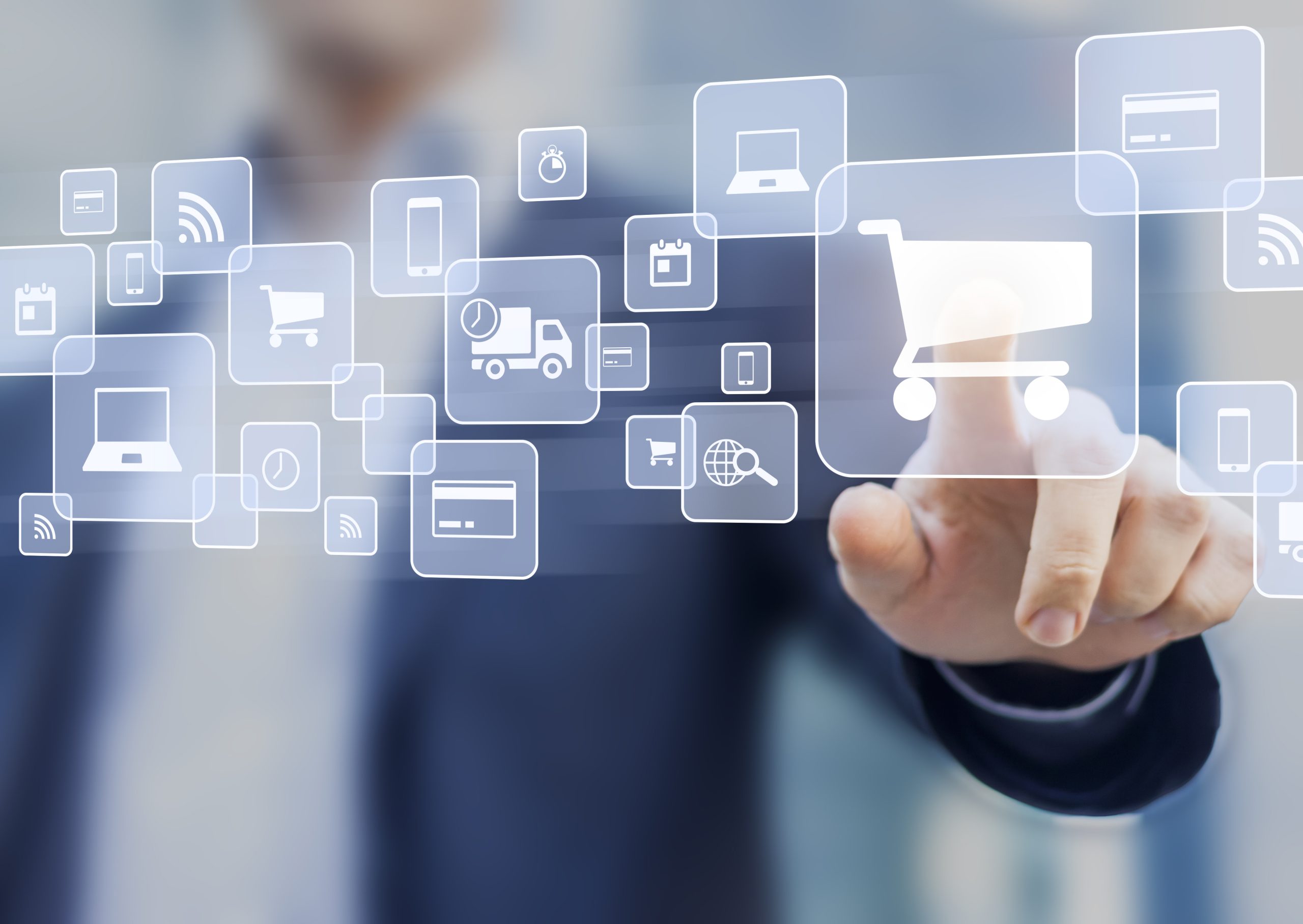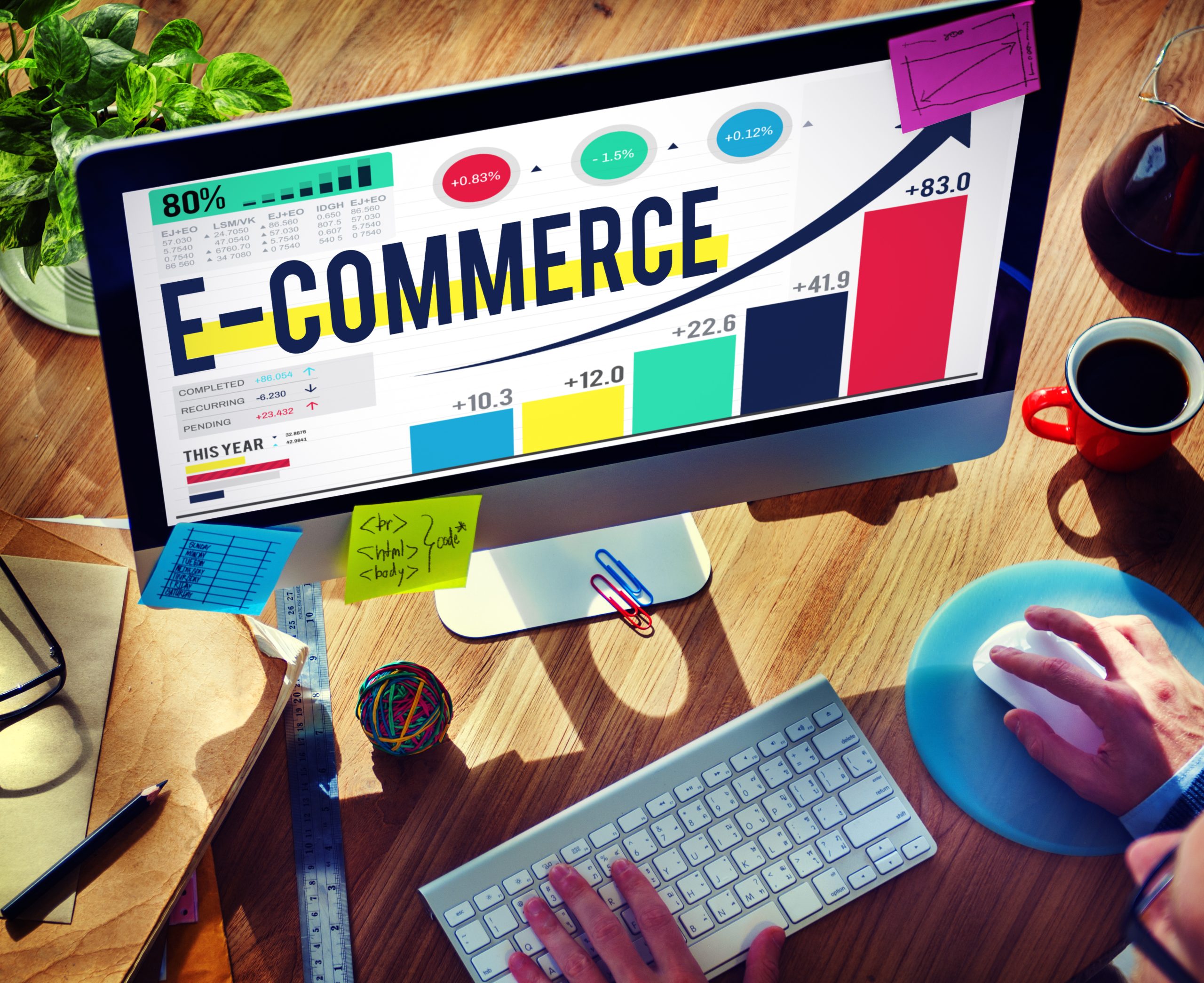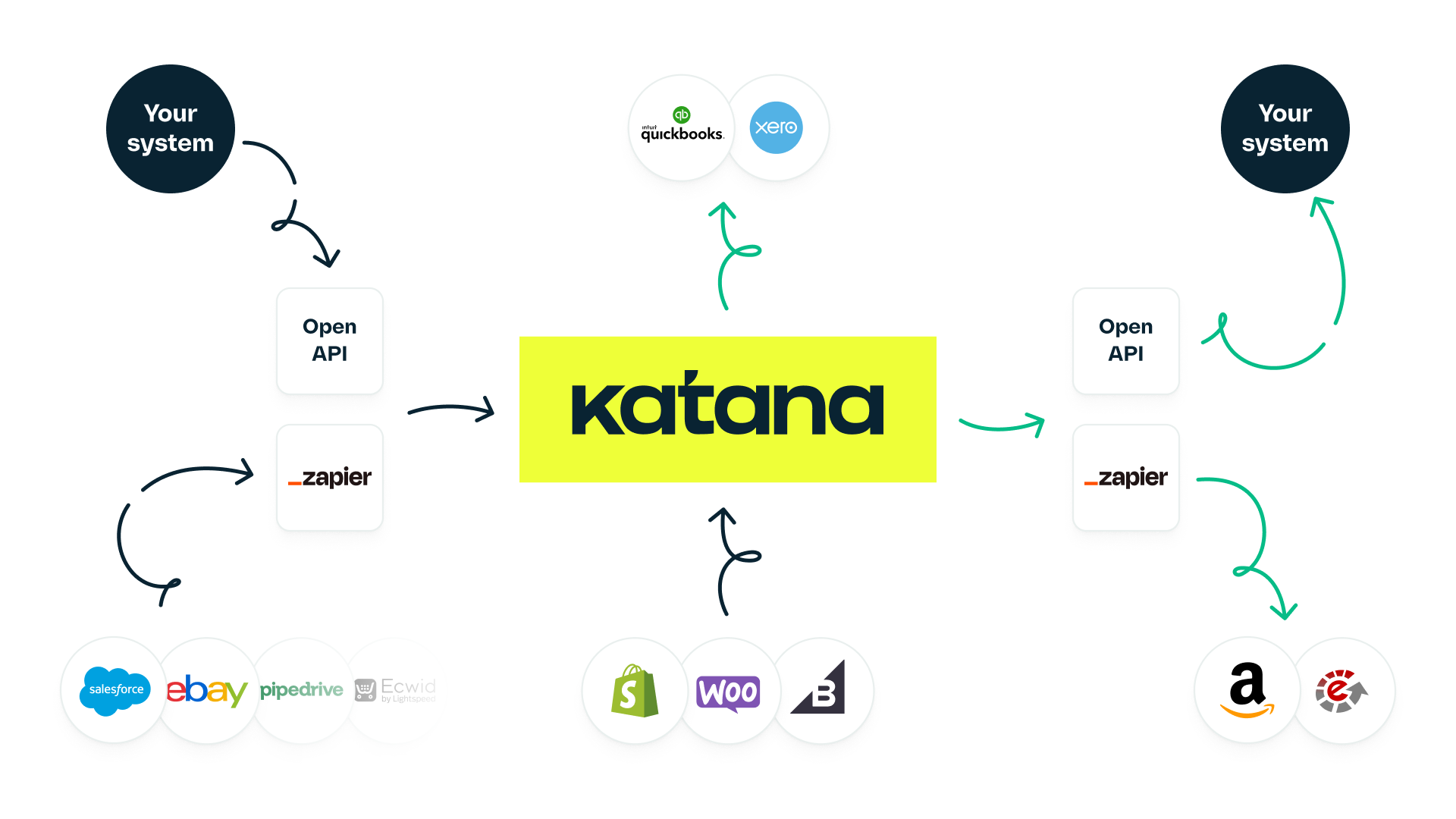E-commerce ERP: Integrate your entire business
Explore the transformative potential of Shopify’s multiple warehouses in this comprehensive guide that delves into the strategies for streamlining operations and enhancing efficiency across multiple locations, paving the way for business growth and customer satisfaction.

Henry Kivimaa

E-commerce sales have been steadily growing ever since the popularization of the World Wide Web. Retail e-commerce reached a staggering $5.8 trillion in global sales in 2023, and this number is expected to keep growing. If we also lump in B2B e-commerce sales, we’ll get close to $9 trillion.
Clearly, it’s a huge market, and making sure everything runs smoothly is no easy feat. Today, we take a look at the systems used to manage it all — e-commerce ERPs.
We see exactly what they are, what are the different types, what are the benefits, and what to look for when choosing an e-commerce ERP system.

What is an e-commerce ERP?
E-commerce ERP refers to the integration of enterprise resource planning (ERP) software with e-commerce platforms aimed at enhancing the efficiency and effectiveness of online business operations. This integration creates a seamless flow of information between an e-commerce website and the back-end accounting, inventory, and order management systems that ERP software provides.
E-commerce ERP integration enables businesses to automate and streamline key processes such as inventory updates, order processing, customer data management, and financial reporting. This synergy helps in achieving real-time visibility into sales, inventory levels, and customer interactions, thereby enabling better decision-making, improved customer service, and more efficient operations.
The integration addresses challenges often faced by e-commerce businesses, including managing high volumes of orders, keeping inventory levels accurate across multiple sales channels, and providing consistent customer experiences. By having a unified system, businesses can avoid issues like overselling, delayed order fulfillment, and inaccuracies in financial reporting.
Next, we’ll go over the different types of e-commerce ERPs you may encounter.

E-commerce ERP types
When talking about e-commerce ERP types, these are generally divided into 3 categories based on how they are implemented;
- On-premise
- Cloud
- Hybrid
On-premise
On-premise e-commerce ERP systems are installed locally on a company’s hardware and servers and then managed by its IT staff. This type of ERP offers complete control over the ERP infrastructure, including security, data management, and customization.
On-premise ERPs are often chosen by organizations with complex operations that require extensive customization or those that prioritize having full control over their data and systems. However, they typically involve higher upfront costs for licenses, hardware, and implementation, as well as ongoing expenses for maintenance and upgrades.
Cloud
Cloud-based e-commerce ERP systems are hosted on the vendor’s servers and accessed via the internet. This model offers a more flexible and scalable approach to ERP, with the advantage of lower initial costs since it usually operates on a subscription-based pricing model.
Cloud ERPs provide ease of access from anywhere, making them ideal for businesses with remote teams or those that need to scale quickly. They also offer automatic updates and maintenance, reducing the IT burden on the company.
Hybrid
Hybrid e-commerce ERP systems combine elements of both on-premise and cloud-based systems. They allow businesses to keep critical applications and sensitive data on-premise for security and compliance reasons while leveraging the cloud for added flexibility, scalability, and cost savings in other areas.
This approach provides the customization and control of on-premise systems with the accessibility and innovation of cloud solutions. Hybrid ERPs are particularly beneficial for companies undergoing digital transformation or those that require specific applications to remain on-premise due to regulatory requirements.
Which one is the best e-commerce ERP depends mostly on your specific business and budget, so be sure to consider all the options carefully.

Benefits of e-commerce ERP
If you currently use stand-alone systems and haven’t even thought about integrating them all, you may wonder about the benefits an e-commerce ERP system can bring. Well, there’s actually quite a substantial list. Let’s go over the 8 most impactful ones.
1. Improved inventory management
One of the biggest benefits that eliminates a lot of mistakes and waste comes thanks to streamlined inventory management. E-commerce ERP systems provide real-time visibility into inventory levels across all sales channels, reducing the risk of stockouts or overstock situations. Automated inventory updates help ensure that product availability on the e-commerce site is always accurate, enhancing customer satisfaction.
2. Streamlined order processing
By automating the order-to-cash process, e-commerce ERPs speed up order processing, reduce manual errors, and ensure that customers receive their orders faster. This integration enables seamless order fulfillment, from payment processing to shipping and delivery.
3. Enhanced customer experience
A unified view of customer interactions and purchases allows businesses to offer personalized experiences, timely customer service, and efficient issue resolution. An e-commerce ERP helps in understanding customer preferences and behavior, leading to improved customer engagement and loyalty.
4. Accurate financial reporting
By integrating financial operations with e-commerce activities, ERP systems provide accurate and timely financial reporting. This aids in better financial management, including expenses, revenue, profits, and tax obligations, enabling more informed decision-making.
5. Efficient multichannel management
For businesses selling on multiple platforms, like marketplaces and different e-commerce platforms, an e-commerce ERP system centralizes management, making it easier to maintain consistency in product listings, pricing, and promotions across all channels.
6. Scalability
As businesses grow, their operations become more complex. E-commerce ERP systems are scalable, meaning they can handle increased volumes of transactions, products, and customers without compromising performance.
7. Reduced operational costs
By automating routine tasks and optimizing business processes, e-commerce ERPs reduce labor costs and minimize errors. The efficiency gains from an integrated ERP system can significantly lower overall operational costs.
8. Better decision-making
With centralized data and advanced analytics capabilities, e-commerce ERP systems provide valuable insights into business performance, customer trends, and market opportunities. This data-driven approach supports strategic planning and helps businesses adapt more quickly to market changes.
Overall, e-commerce ERP integration equips businesses with the tools they need to operate more effectively, satisfy customers, and stay competitive. These benefits greatly outweigh the costs of implementing an e-commerce ERP.
Next, we’ll go over some of the main functionalities you should look out for when choosing the best e-commerce ERP for your business.
Features to look for in an e-commerce ERP
When choosing a system, it’s crucial to consider features that align with your business needs, streamline operations, and enhance customer experiences. Below, you’ll find the key features to look for.
Real-time inventory management
The ERP should offer real-time visibility into inventory levels across all sales channels, enabling accurate stock management and avoiding overstock or stockouts. This feature should support automatic updates as sales are made and items are restocked.
Seamless integration capabilities
Look for an ERP that easily integrates with your existing e-commerce platform, CRM software, shipping providers, and other third-party applications. Seamless integration ensures smooth data flow across systems, improving operational efficiency.
Order management and fulfillment
An effective e-commerce ERP should streamline the entire order management process, from order receipt and processing to shipping and delivery. It should automate tasks such as order tracking, returns processing, and customer communication.
Financial management and accounting
Comprehensive financial management features or seamless integration with existing accounting software is vital for tracking sales, expenses, and profitability. This makes keeping an eye on your finances a lot easier and less error-prone
Analytics and reporting
Advanced analytics and reporting capabilities enable businesses to gain insights into their operations, customer behavior, and market trends. Look for an ERP that offers reports and dashboards to support data-driven decision-making.
Scalability
Choose an e-commerce ERP system that can grow with your business. It should be scalable to accommodate new products, more transactions, and additional sales channels without requiring a complete system overhaul.
User-friendly interface
This gets often overlooked, but a user-friendly system is critical to ensure everybody gets up-to-speed quickly and starts using it properly. The system should have an intuitive interface that makes it easy for your team to navigate and use effectively. This reduces training time and increases productivity.
Mobile accessibility
With the increasing need for on-the-go access, an ERP that offers mobile accessibility allows you and your team to monitor operations, manage orders, and access data from anywhere, at any time.
These are some of the main features you should look out for, but be sure to add your own specific requirements to the list that would simplify your life.

E-commerce ERP best practices
Implementing an ERP for your e-commerce business can be a game-changer. But the devil is in the details, so careful planning and execution are key. As with any major project, specifics may vary, but keeping these best practices in mind should help you keep your project on time and within budget:
Involve stakeholders from the get-go
A successful e-commerce ERP integration requires buy-in from everyone. Involve all key decision-makers early on to understand their needs and concerns. Keep everyone informed and invested in the process, ensuring a smooth transition for all departments.
Develop a watertight integration plan
ERP integrations rarely go smoothly, so craft a detailed plan that outlines the project’s objectives and long-term benefits, and make sure to include contingency measures for unforeseen blockages.
Cleanse your data for a seamless integration
Clean data is the basis of an efficient ERP implementation. Before integrating, spare some time to audit and clean your existing data, checking accuracy, removing duplicates, etc.
Prioritize security
Security is non-negotiable when integrating an ERP. Triple-check that both your own systems and any third parties have what it takes to safeguard sensitive customer data — at rest as well as in transit.

Integrating all your business services
Being able to integrate all your apps will streamline your operations while giving you a central source of truth. That’s why it’s essential to look for an ERP system that can effortlessly link up your existing tools.
E-commerce ERP systems can be integrated through three main approaches:
- Native integrations
- Third-party integrations
- Custom integrations via an open API
Understanding the differences between these integration types and their benefits is key to optimizing your e-commerce operations.
Native integrations
Native integrations are built directly into the ERP system by the software provider. These integrations are designed to work seamlessly with specific platforms, applications, or services without the need for additional software or middleware. The main advantage of native integrations is their reliability and ease of use, as they are maintained by the ERP vendor and designed to offer a smooth user experience. However, the range of native integrations may be limited to the most popular platforms or those deemed most critical by the ERP vendor.
Third-party integrations
Third-party integrations are developed by external providers to connect the ERP system with other software applications or services. These integrations may be available through an app marketplace or as add-ons and can extend the functionality of the ERP system to meet specific business needs. While third-party integrations offer flexibility and a wide range of options, they may require additional setup and maintenance efforts. It’s important to assess the reliability and support available for these integrations to ensure they meet your business requirements.
Custom integrations via open API
For businesses with unique needs or those using niche platforms, custom integrations via an open API (application programming interface) provide a highly flexible solution. An open API allows developers to build custom integrations that connect the ERP system with virtually any other software application or service. This approach enables tailored solutions that fit specific operational workflows or data exchange requirements. While custom integrations offer the highest level of customization, they also require development resources and expertise, making them more suited to businesses with specific integration needs not met by native or third-party options.
Benefits of integrations
This all may seem like a lot of work, but integrating your e-commerce ERP with other business services offers many benefits to make it worthwhile:
- Efficiency and productivity — Automating data exchange between systems reduces manual data entry, minimizes errors, and saves time, allowing staff to focus on higher-value activities.
- Real-time data access — Integrations enable real-time data flow, ensuring that inventory levels, customer information, and financial data are always up to date across all platforms.
- Enhanced customer experience — By integrating CRM, marketing, and customer service tools, businesses can offer personalized experiences and respond more quickly to customer needs.
- Informed decision-making — Consolidating data from various sources provides a comprehensive view of business operations, supporting better strategic decisions.
- Scalability — As your business grows, integrations allow you to easily add new platforms, channels, or functionalities without disrupting existing operations.
Choosing the right mix of native, third-party, and custom integrations allows businesses to create a highly efficient, interconnected ecosystem that supports their unique operational needs and growth objectives.
Bring it all together with Katana
If you’re looking for the best ERP for e-commerce, look no further. Katana is the perfect platform for businesses selling on multiple online stores. It offers native integrations with the best e-commerce platforms and accounting tools:
In addition, you get a ton of 3rd party integrations through Zapier and Integromat, and you also have access to an open API to build your own custom workflows.
Besides all the connectivity options, Katana also offers features to take control of your inventory, sales, production, and much more. It enables you to:
- Monitor inventory in real time
- Measure business metrics
- Manage orders
- Plan your inventory
- Schedule production
- Manage multiple sales channels
If you have any questions or want to see more on how Katana can help your business grow, book a demo today.
E-commerce ERP FAQs
What’s the difference between an ERP and a CRM?
- An ERP system integrates and manages core business processes, such as inventory, supply chain, finance, and human resources, across an organization to improve efficiency and data accuracy.
- A CRM (customer relationship management) system, on the other hand, focuses on managing interactions with current and potential customers, aiming to improve business relationships, increase customer retention, and drive sales growth.
While ERP is centered on streamlining internal operations, CRM is dedicated to enhancing customer relationships and sales strategies.
What is an ERP in e-commerce?
An ERP in e-commerce integrates various business functions like inventory management, order processing, customer relationship management, and finance into a single system, optimizing the operations of an e-commerce business for efficiency and scalability.
Is Shopify an ERP?
No, Shopify is not an ERP. Shopify is an e-commerce platform designed to help businesses set up, manage, and scale online stores. It provides tools for storefront design, product management, sales, and basic analytics but does not offer the extensive back-office functionalities of an ERP system.

Henry Kivimaa
Table of contents
Get inventory trends, news, and tips every month
Get visibility over your sales and stock
Wave goodbye to uncertainty with Katana Cloud Inventory — AI-powered for total inventory control